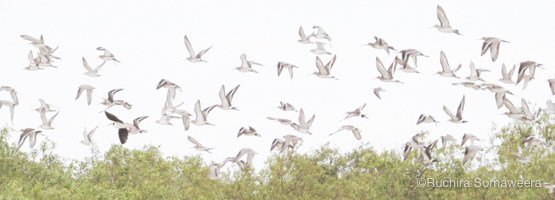14 October 2019
Prawns, barra and shorebirds; cyclones, mud and floods: it’s been a busy six months for Hub researchers investigating how river flows affect ecosystem productivity in the southern Gulf of Carpentaria.
Hub scientists capitalised on the most significant flood event on the Flinders River in the last 50 years, by chartering a helicopter to collect samples from the river’s plume at the peak of flooding in February. This was followed by boat-based fieldwork in March to sample water quality, estuary productivity and shorebird food availability as the floodwaters receded. The Carpentaria Land Council Aboriginal Corporation have also been counting shorebirds roosting near the Flinders River several times in the past six months, to give a picture of when and how many birds are using the area.
The Carpentaria Land Council Aboriginal Corporation have also been counting shorebirds roosting near the Flinders River several times in the past six months.

Back in the lab, scientists have processed prawn samples from late 2018 showing the importance of freshwater flows for prawn production and catch. They have also compared the microchemistry of water samples and barramundi ear bones to better understand how the fish use river habitats, and how changes in flows might affect this.
And they’ve been on the road, presenting their findings to stakeholders from Karumba to Cairns to Canberra.
A new update on the Hub’s Gulf river research, led by Professor Michele Burford of Griffith University, is now available.
Photo courtesy Carpentaria Land Council Aboriginal Corporation.
Want to know more about the Resilient Landscapes Hub's activities and our research into practical solutions to environmental problems? Stay informed about activities, research, publications, events and more through the Hub newsletter.